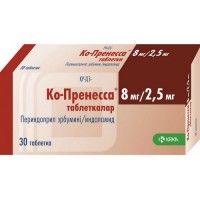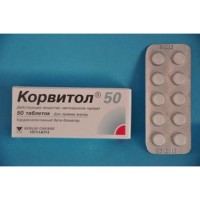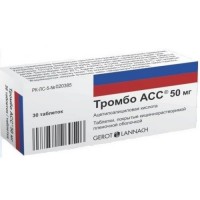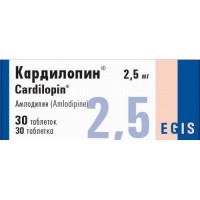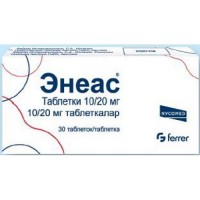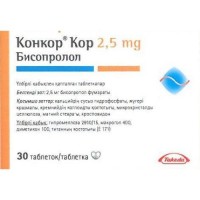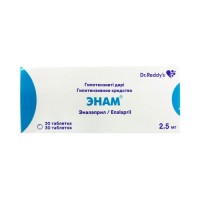Ko Telsakor-Teva 80 mg / 25 mg (30 tablets)
- $20.10
Sku:
01a8874881c7
The instruction for medical use of medicine of Co-Telsakor-Teva the Trade name of Co-Telsakor-Teva Mezhdunarodnoye the unlicensed name Is not present the Dosage form of the Tablet of 80 mg / 12.5 mg, 80 mg / 25 mg Structure One tablet contains active agents: telmisartan 80 mg hydrochlorothiazide of 12.5 mg or 25 mg respectively, excipients: sodium hydroxide, a hydroksipropilmetiltsellyuloza 3 sr, lactoses monohydrate, hydroxypropyl cellulose, sorbitol, meglumin, Mannitolum, talc, magnesium stearate, ferrous oxide red (E172) (for a dosage 80/12.5), ferrous oxide yellow (E172) (for a dosage 80/25). Description of the Tablet of a capsulovidny form, two-layer: one layer – white color, another – red color, with the line of a break on the red party (for a dosage of 80/12.5 mg). Tablets of a capsulovidny form, two-layer: one layer – from white till almost white color, another – yellow color, with the line of a break on the yellow party (for a dosage of 80/25 mg). Pharmacotherapeutic group the Drugs influencing a system renin - angiotensin. Angiotensin II antagonists in a combination with other drugs. Angiotensin II antagonists in a combination with diuretics. Telmisartan and diuretics. The ATX C09DA07 code the Pharmacological Pharmacokinetics Simultaneous Use properties of a hydrochlorothiazide and telmisartan does not influence pharmacokinetics of each of drug components. Absorption Telmisartan: after intake telmisartan it is absorbed quickly, the maximum concentration of a telmisartan is reached in 0.5-1.5 h. Average absolute bioavailability of a telmisartan – about 50%. Meal slightly reduces bioavailability of a telmisartan with reduction of value of the area under a curve concentration in plasma - time (AUC) from 6% at reception in a dose of 40 mg to 19% at reception in a dose of 160 mg. In 3 h after reception of a telmisartan the concentration in blood plasma is stabilized and does not depend on meal. Insignificant reduction of AUC does not cause decrease in therapeutic effectiveness. The pharmacokinetics of a telmisartan at oral administration has nonlinear character at reception of doses in the range of 20 mg - 160 mg with more than proportional increase in concentration in plasma (Cmax and AUC) at increase in a dose. Telmisartan does not collect in blood plasma considerably at repeated use. Hydrochlorothiazide: after intake the maximum concentration of a hydrochlorothiazide is reached approximately in 2 hours after reception. The absolute bioavailability of Hydrochlorthiazidum is about 60%. Distribution Telmisartan: possesses high extent of linking with proteins of plasma (& gt, 99.5%), generally with albumine and alfa-1 an acid glycoprotein. The volume of distribution is about 500 l. Hydrochlorothiazide: for 68% contacts proteins of plasma and its visible volume of distribution is 0.03-1.14 l/kg. Metabolism and removal Telmisartan: after oral administration of a 14C-mechenny telmisartan the most part of a dose (& gt, 97%) was removed with a stake by biliary excretion, very insignificant quantities were found in urine. It is metabolized by a konjyugirovaniye of initial substance with pharmacological inactive acylglucuronide, the only thing glyukoronidy, identified at the person. After use of one dose of a 14C-mechenny telmisartan glyukoronid about 11% of the measured radioactivity in blood plasma are found. Isoenzymes of P450 cytochrome do not participate in metabolism of a telmisartan. The general plasma clearance of a telmisartan is about 800 ml/min. Hydrochlorothiazide: at the person not metaboliziruyetsyasya it is also allocated almost completely in not changed view with urine. About 60% of the dose accepted inside are removed in the form of not changed substance within 48 hours. Final elimination half-life of a hydrochlorothiazide makes 10-15 hours. Patients of advanced age: the pharmacokinetics of a telmisartan at patients of advanced age more young does not differ than 65 years. Patients with a renal failure the Renal excretion does not affect clearance of a telmisartan. Based on excretion level at patients with easy to average degree of a renal failure (clearance of creatinine of 30-60 ml/min., on average about 50 ml/min.), any correction of the mode of dosing is not required. Telmisartan does not leave at dialysis. At patients with renal failures the clearance rate of a hydrochlorothiazide is reduced. In a research at patients with average clearance of creatinine of 90 ml/min. the elimination half-life of a hydrochlorothiazide was increased. At patients with a nonfunctioning kidney the elimination half-life makes about 34 hours. It is recommended to carry out periodic control of function of kidneys. Patients with a liver failure At patients with a liver failure the increase in absolute bioavailability up to 100% is observed. Elimination half-life does not change in a liver failure. Drug gets through a placental barrier and is defined in umbilical cord blood. The pharmacodynamics of Co-Telsakor-Teva represents a combination of the antagonist of receptors of angiotensin II – a telmisartan and thiazide diuretic – a hydrochlorothiazide. The combination of these components provides higher level of antihypertensive effect, than reception of each of components separately. Administration of drug of Co-Telsakor-Teva in therapeutic doses provides once a day an effective and smooth lowering of arterial pressure. Telmisartan: is an effective and specific (selection) antagonist of receptors of angiotensin II (AT1 type). Telmisartan with very high degree of affinity forms communication only with AT1 subtype – angiotensin II receptors. Telmisartan has no affinity to other receptors, including to AT2 – angiotensin receptors, and to others, less studied, AT to receptors. The functional value of these receptors and also effect of their possible excess stimulation by angiotensin II which concentration increases when assigning a telmisartan, are not studied. Telmisartan leads to decrease in level of Aldosteronum in blood. Telmisartan does not inhibit renin in plasma of the person and does not block ion channels. Telmisartan does not suppress activity of angiotensin-converting enzyme (kinase of II) to which participation there is a decrease in synthesis of bradykinin. Therefore there is no strengthening of the side effects caused by bradykinin. At patients telmisartan in a dose of 80 mg almost completely blocks hypertensive effect of angiotensin II. Inhibiting effect remains within 24 hours, including the last 4 hours before reception of the next dose. After reception of the first dose of a telmisartan the antihypertensive activity gradually becomes noticeable within 3 hours. The maximum lowering of arterial pressure (ABP) is gradually reached in 4 weeks after an initiation of treatment and supported during long-term treatment. At patients with hypertensia telmisartan reduces systolic and diastolic arterial blood pressure without change of heart rate. In case of sharp cancellation of a telmisartan of the ABP gradually returns to values before treatment within several days without signs of fast resuming of hypertensia (there is no syndrome of cancellation). Hydrochlorothiazide: is thiazide diuretic. Thiazide diuretics influence a reabsorption of electrolytes in renal tubules, directly increasing excretion of sodium and chlorides (approximately in equivalent quantities). Diuretic effect of Hydrochlorthiazidum leads to reduction of volume of the circulating blood, increase in activity of renin of plasma, increase in secretion of Aldosteronum and is followed by increase in content in urine of potassium and bicarbonates and also a hypopotassemia. At a concomitant use of a telmisartan the tendency to the termination of the loss of potassium caused by these diuretics, presumably due to blockade system renin-angiotensin-aldosteronovoy is noted. After intake of Hydrochlorthiazidum the diuresis amplifies in 2 hours, and the maximum effect is observed approximately in 4 hours. Diuretic effect of drug remains about 6-12 hours. Prolonged use of Hydrochlorthiazidum reduces risk of development of complications of cardiovascular diseases and mortality from them. The maximum antihypertensive effect of Co-Telsakor-Teva is usually reached in 4 weeks after an initiation of treatment. Indications - treatment of arterial hypertension (in case of inefficiency of a telmisartan or a hydrochlorothiazide in the form of monotherapy) accept the Route of administration and doses of Co-Telsakor-Teva once a day, washing down with a small amount of water, irrespective of meal. / 12.5 patients at whom Telsakor-Tev's use in a dose of 80 mg does not lead to normalization of the ABP can appoint Co-Telsakor-Teva of 80 mg mg. / 25 can appoint Co-Telsakor-Teva of 80 mg mg patients who have Telsakor-Tev's use in a dose 80 mg or Co-Telsakor-Teva of 80 mg / 12.5 the mg does not lead to normalization to the ABP or patients whose condition was stabilized telmisartany or a hydrochlorothiazide at separate use earlier. A renal failure In view of presence at composition of drug of Hydrochlorthiazidum patients should not appoint with a severe form of a renal failure (clearance of creatinine & lt, 30 ml/min.). Experience of use for patients with insignificant or moderate renal failures is limited, but available data do not indicate an adverse effect on kidneys therefore dose adjustment is not required. Elderly patients Correction of a dose is not required. Children and teenagers Drug is not recommended to be used to patients aged up to 18 years due to the lack of data on safety and efficiency. Side effects the Undesirable phenomena observed during clinical trials of a combination of a telmisartan and hydrochlorothiazide are given in the table below with use of the following classification: often ≥1/100 to & lt, 1/10, infrequently ≥1/1000 to & lt, 1/100, is rare ≥1/10000 to & lt, 1/1000, also lt, 10000 is very rare. Often (≥1/100 to & lt, 1/10) - dizziness (vertigo) Infrequently (≥1/1000 to & lt, 1/100) - a hypopotassemia - alarm, decrease in efficiency of antidiabetic therapy - arrhythmia, tachycardia - hypotension (including orthostatic hypotension) - a stethalgia - short wind - a dorsodynia, muscular spasms, myalgia - syncope/weakness, paresthesias, perspiration - diarrhea, dryness in a mouth, a meteorism - decrease in potency - increase in level of uric acid Seldom (≥1/10000 to & lt, 1/1000) - bronchitis, pharyngitis, sinusitis - a respiratory distress (including pneumonia and a fluid lungs) - aggravation or activation of a system lupus erythematosus (it is based on post-marketing data) - a hyponatremia - a depression - a sleep disorder, insomnia - a disorder of vision, temporary decrease in visual acuity - abdominal pain, a constipation, dyspepsia, vomiting, gastritis - liver abnormal liver functions / diseases * (a *bolshy part of cases of the abnormal liver functions observed during the post-registration period was observed at patients in Japan who are more inclined to development of such undesirable reactions) - increase in level of creatinine, increase in activity of liver enzymes, increase in kreatinfosfokinaza blood - interstitial nephrite, dysfunction of kidneys - a Quincke's disease (including a lethal outcome), an erythema, an itching, rash, increase in perspiration, urticaria - an arthralgia, onychalgias, spasms in legs - grippopodobny symptoms, pain the Frequency of the side effects connected directly with influence of a telmisartan (according to clinical trials at monotherapy telmisartany at patients with a hypertension or at patients of 50 years and is more senior with high risk of cardiovascular complications) Infrequently (≥1/1000 to & lt, 1/100) - upper respiratory tract infections, infections of urinary tract (including cystitis) - anemia - a hyperpotassemia - bradycardia - renal failures, including an acute renal failure (see. also Special instructions) - an asthenia (weakness) Seldom (≥1/10000 to & lt, 1/1000) - sepsis (including cases with a lethal outcome) - thrombocytopenia, an eosinophilia - a hypoglycemia (at patients with diabetes - decrease in level of hemoglobin) - anaphylactic reactions, hypersensitivity - dyspepsia - eczema, medicamentous rash, toxic rash - arthrosis, sinew pain (tendinitopodobny symptoms) the Frequency of the side effects connected directly with influence of a hydrochlorothiazide (the additional side effects revealed at monotherapy by Hydrochlorthiazidum) It is very frequent (& gt, 1/10) - increase in level of lipids in blood (generally at reception of high doses) Is frequent (from & gt, 1/100 to & lt, 1/10) - a small tortoiseshell and other forms of rash - anorexia, loss of appetite, moderate nausea and vomiting - postural hypotension which can amplify under the influence of alcohol, anesthetics or sedatives - a hypomagnesiemia, a hyperuricemia Seldom (from & gt, 1/10000 up to 1/1000) - a hypercalcemia, a hyperglycemia, a glucosuria and deterioration in the diabetic metabolic status - a hypovolemia (reduction of volume of the circulating blood) - thrombocytopenia, sometimes with a purpura - reactions of photosensitivity - discomfort of digestive tract, a constipation, diarrhea - an intra hepatic cholestasia or jaundice, pancreatitis - arrhythmia - a headache, dizziness, sleep disorders, a depression and paresthesia, concern - disorders of vision, a kspantopsiya (an image of objects in yellow color), a sharp myopathy, acute closed-angle glaucoma Very seldom (& lt, 1/10000) - the necrotizing vasculitis and a toxic epidermal necrolysis, skin reactions reminding a system lupus erythematosus, aggravation of skin manifestations of a system lupus erythematosus - the leukopenia/neutropenia, an agranulocytosis, oppression of function of marrow, hemolytic anemia, aplastic anemia - a gipokhloremichesky alkalosis Were reported the following side effects which frequency is not established: a sialadenitis, muscular spasms, a renal failure, a renal failure, interstitial nephrite, fever, weakness, a water-salt imbalance (hyponatremia, a hypopotassemia) of the Contraindication - hypersensitivity to active agents, to any of auxiliary components or to other derivatives of sulfonamides (the hydrochlorothiazide is derivative sulfonamide) - a cholestasia and obstructive diseases of biliary tract - abnormal liver functions - a heavy renal failure (clearance of creatinine & lt, 30 ml/min.) - a resistant hypopotassemia, a hypercalcemia - hereditary intolerance of fructose, galactoses (galactosemia) - joint administration of drug - Co-Telsakor-Teva with aliskireny at patients with diabetes 2 types or a renal failure (clearance of creatinine & lt, 60 ml/min.) - pregnancy and the period of a lactation - children's and teenage age up to 18 years (the efficiency and safety is not established) Medicinal interactions At combined use of Co-Telsakor-Teva with: - lithium observes exceptional cases of reversible increase in concentration of lithium in serum of blood and development of intoxication by lithium owing to decrease in renal clearance of lithium. In this regard combined use of lithium and Co-Telsakor-Teva is not recommended. In need of joint prescribing of these drugs it is necessary to carry out monitoring of level of lithium in blood plasma, and patients have to be under strict observation of the doctor, - the drugs leading to loss of potassium and a hypopotassemia (potassium diuretics, laxatives, corticosteroids, adrenal hormones, Amphotericinum, karbenoksolon, sodium salt of penicillin G, salicylic acid and its derivatives), it is necessary to carry out stringent control of level of potassium in blood plasma. These drugs can enhance gipokaliyemichesky effect of Hydrochlorthiazidum. When prescribing these medicines along with Co-Telsakor-Teva it is recommended to carry out monitoring of level of potassium in blood plasma, - the drugs oppressing renin-angiotenzinovuyu a system, along with kaliysberegayushchy diuretics, potassium additives, potassium - the containing substitutes of salt and other drugs which can promote increase in level of potassium (for example, sodium salt of heparin), increase in level of potassium in blood serum is possible. If prescribing of these medicines with Co-Telsakor-Teva is necessary, it is recommended to control potassium level in blood plasma, - it is necessary to carry out by the medicines depending on fluctuation of level of potassium in blood (foxglove glycosides), antiarrhytmic means periodic monitoring of level of potassium in blood serum and carrying out electrocardiography as a hypopotassemia yavlyaets
the contributing factor for developing of Bouveret's ventricular disease like pirouette, - non-steroidal anti-inflammatory drugs decrease in diuretic, natriuretic and antihypertensive effects of thiazide diuretics at some patients is possible. At elderly patients and the dehydrated patients the risk of developing an acute renal failure can increase therefore it is necessary to carry out sufficient hydration and monitoring of function of kidneys, - other antihypertensive drugs potentiation of their hypotensive effect is possible, - telmisartany and ramiprily leads to increase in AUC0-24 and Cmax of a ramipril and the ramiprilat to 2.5 times. The clinical importance of this observation is not known, - alcohol, barbiturates, drugs potentiation of orthostatic hypotension is possible, - antidiabetic means (peroral and insulin) can be required dose adjustment of antidiabetic means, - risk of development of the laktatsidoz caused by joint purpose of a hydrochlorothiazide - holestiraminy arises metformin and cholesteric pitches break absorption of a hydrochlorothiazide, - glycosides of a foxglove the hypopotassemia or a hypomagnesiemia caused by tiazida is possible that can promote the beginning of the cardiac arrhythmia induced by foxglove glycosides - pressor amines (noradrenaline) influence of pressor amines decreases, - not depolarizing relaxants of skeletal muscles (tubocurarine) is observed potentiation of effect not depolarizing relaxants, - drugs for treatment of gout can be required dose adjustment of uricosuric means as the hydrochlorothiazide is capable to increase the level of uric acid in blood serum. Joint reception with Allopyrinolum can lead to reaction of hypersensitivity to Allopyrinolum, - salts of calcium increase in level of calcium in blood because of reduction of its elimination is possible. If vitamins, calciferous are appointed, it is necessary to carry out control of its level to blood and, respectively, to correct a dose, - beta-blockers and diazoxide potentiation of hyper glycemic effect of beta-blockers and diazoxide is possible, - anticholinergics (atropine, Biperidinum) increase in bioavailability of thiazide diuretics by reduction of motility of digestive tract and speed of gastric emptying is possible, - amantadiny increase in risk of development of the side effects caused by reception of an amantadin is possible - cytotoxic drugs (cyclophosphamide, a methotrexate) decrease in renal excretion of cytotoxic drugs and potentiation of their myelosuppressive effects is possible. Sharing of Co-Telsakor-Teva with digoxin, warfarin, a hydrochlorothiazide, glibenclamide, an ibuprofen, paracetamol, simvastatiny and amlodipiny does not lead to clinically significant interaction. At simultaneous use with digoxin the increase in average minimum concentration of digoxin in blood plasma for 20% (in an isolated case for 40%) therefore it is necessary to carry out monitoring of level of digoxin in blood plasma was observed. Special instructions the Liver failure At patients with abnormal liver functions or the progressing diseases of a liver of Co-Telsakor-Teva it has to be applied with care as even little changes of water and electrolytic balance can contribute to the development of a hepatic coma. Renovascular hypertensia At patients with a bilateral stenosis of the renal arteries or a stenosis of an artery of the only functioning kidney taking medicines which influence renin-angiotensin-aldosteronovuyu a system exists the increased risk of developing heavy hypotension and renal failure. A renal failure and transplantation of a kidney Experience of use of Co-Telsakor-Teva for patients with small or moderate renal failures limited therefore periodic control of level of potassium, creatinine and uric acid in serum is recommended. At patients with a renal failure the azotemia connected with use of thiazide diuretics can develop. Decrease in the volume of the circulating blood (VCB) At patients with reduced OCK and/or reduced content of sodium owing to intensive care by diuretics, decrease in consumption of salt with food, diarrhea or vomiting, can be observed symptomatic hypotension, especially after reception of the first dose. Such states should be adjusted before purpose of Co-Telsakor-Teva. Double blockade system renin-angiotensin-aldosteronovoy (SRAA): At combined use of the medicines influencing RAAS owing to blocking of this system changes of function of kidneys (including an acute renal failure) at patients with pathology of kidneys were revealed. Therefore use of double blockade of RAAS (for example, at addition of APF inhibitor to the antagonist of receptors of angiotensin II) have to be special cases on condition of careful monitoring of function of kidneys. Other states connected with stimulation of RAAS U of patients with a reduced vascular tone and the function of kidneys substantially depending on activity of RAAS (for example, patients with heavy stagnant heart failure or a serious illness of kidneys, including a renal artery stenosis), treatment of Co-Telsakor-Teva with other drugs influencing this system can result in risk of developing acute hypotension, a hyperazotemia, oliguria or, in rare instances, of an acute renal failure. Primary aldosteronism Patients with primary aldosteronism usually do not react to treatment by the antihypertensive drugs operating by means of RAAS inhibition. Therefore use of Co-Telsakor-Teva is not recommended. The stenosis of an aorta and the mitral valve, a subaortic hypertrophic stenosis As well as when using other vasodilating drugs use Co-Telsakor-Teva demands extra care from the patients having an aortal or mitral stenosis or a subaortic hypertrophic stenosis. Metabolic and endocrine effects At patients with diabetes the change of a dose of insulin or hypoglycemic means for intake can be required. During performing therapy by thiazide diuretics manifestation latentno of the proceeding diabetes is possible. Communication between increase in level of cholesterol and triglycerides and use of thiazide diuretics was found, however at use of drug of Co-Telsakor-Teva with the maintenance of 12.5 mg of a hydrochlorothiazide the minimum effect or its absence was noted. At some patients receiving treatment of Co-Telsakor-Teva the hyperuricemia and attacks of gout can be observed. Disturbance of water and electrolytic balance Both at use of drug of Co-Telsakor-Teva, and in case of performing diuretic therapy the periodic control of content of electrolytes in blood serum is necessary. Thiazide diuretics, including a hydrochlorothiazide, can cause disturbance of water and electrolytic balance and an acid-base state (hypopotassemia, a hyponatremia and a gipokhloremichesky alkalosis). The signs guarding concerning these disturbances are the dryness of a mucous membrane of an oral cavity, feeling of thirst, the general weakness, drowsiness, feeling of concern, myalgia or convulsive twitchings of gastrocnemius muscles (spasm), muscle weakness, arterial hypotension, an oliguria, tachycardia and such gastrointestinal disturbances as nausea or vomiting. At use of thiazide diuretics the hypopotassemia can develop, but at the same time applied telmisartan can increase potassium content in blood. The risk of a hypopotassemia most increases at patients with cirrhosis, in a profound diuresis, at observance of a saltless diet and also in case of simultaneous use glyuko- and mineralokortikosteroid or corticotropin. Telmisartan who is a part of drug of Co-Telsakor-Teva, on the contrary, can lead to a hyperpotassemia owing to antagonism to angiotensin II receptors (AT1 subtype). Though at use of drug of Co-Telsakor-Teva clinically significant hyperpotassemia was not registered, it is necessary to take into account that renal and/or heart failure and diabetes belong to risk factors of its development. Data that drug of Co-Telsakor-Teva can reduce or prevent the hyponatremia caused by intake of diuretics no. The hypochloraemia is usually insignificant and does not demand treatment. Thiazide diuretics can reduce calcium removal by kidneys and cause (in the absence of obvious disturbances of metabolism of calcium) passing and small increase in content of calcium in blood serum. More expressed hypercalcemia can be symptom of the latent hyperparathyreosis. Before evaluating function of epithelial bodies thiazide diuretics have to be cancelled. It is shown that thiazide diuretics increase magnesium removal by kidneys that can lead to a hypomagnesiemia. When using antihypertensive substances the sharp and excessive decrease in the ABP at patients with an ischemic cardiopathy or an ischemic cardiovascular disease can lead to a myocardial infarction or development of a stroke. Acute shortsightedness and secondary closed-angle glaucoma the Hydrochlorothiazide which is to sulfonamide derivatives can cause the reaction of an idiosyncrasy (individual intolerance) leading to developing of short-term acute shortsightedness and secondary closed-angle glaucoma. Symptoms include acute onset of decrease in visual acuity or eye pain that is usually observed during the period from several hours to several weeks from the moment of the beginning of administration of drug. The lack of treatment of acute closed-angle glaucoma can lead to irreversible loss of sight! Primary treatment consists in the urgent termination of reception of a hydrochlorothiazide! Immediate medical or surgical treatment can be necessary if it is not possible to restore intraocular pressure. Risk factors of developing acute closed-angle glaucoma can include existence in the anamnesis allergic reaction to sulfonamide or penicillin. The general Hypersensitivity reactions to a hydrochlorothiazide can be observed at patients even in the absence of an allergy or bronchial asthma in the anamnesis, however are more likely noted in the presence of these diseases. There are messages about aggravation or activation of a system erythematic lupus when using thiazide diuretics. Features of influence of medicine on ability to run the vehicle or potentially dangerous mechanisms of the Research of influences on ability to driving of motor transport and to control of mechanisms were not carried out. The control of motor transport or devices should be limited during performing antihypertensive therapy because of a possibility of development of dizziness or drowsiness. Overdose Symptoms: arterial hypotension, tachycardia, bradycardia, nausea, drowsiness. The overdose hydrokhlotiazidy is connected with dehydration and decrease in content of electrolytes (hypopotassemia, a hypochloraemia) as a result of an excessive diuresis. The hypopotassemia can lead to a spasm of muscles and/or strengthening of the arrhythmia of heart connected with the combined use of glycosides of a digitalis or some antiarrhytmic drugs. Treatment: symptomatic. Patients have to be under fixed observation, and it is necessary to carry out the symptomatic and supporting treatment depending on time after reception and weight of symptoms. Control of electrolytes and creatinine in serum should be carried out through frequent intervals. In case of hypotension the patients have to be placed in a dorsal decubitus, it is necessary to carry out urgently compensation of electrolytes and volume of the circulating blood. Telmisartan does not leave from blood a hemodialysis, extent of removal of a hydrochlorothiazide when carrying out a hemodialysis is not established. The form of release and packing On 10 tablets place in blister strip packaging from aluminum foil. On 3 planimetric packs together with the instruction for use in the state and Russian languages place in a pack from cardboard. On 500 (for 80 mg/12.5 mg) or 100 (for 80 mg / 25 mg) tablets place in bottles from polyethylene of high density with a polypropylene cover. 3 years not to apply a period of storage after an expiration date. To Store storage conditions in the dry, protected from light place at a temperature not above 25 °C. To store out of children's reach! Prescription status According to the prescription Tevapharm India Private Limited Producer, India the Name and the country of the owner of the registration certificate of Teva Pharmaceutical Industries Ltd, Israel the Packer of Pliva Hrvatska d.o.o., Croatia the Address of the organization in the territory of the Republic of Kazakhstan the accepting claim (offer) from consumers on quality of medicine of ratiofarm Kazakhstan LLP Almaty, Al-Farabi Ave. 19, BC Nurly-Tau block 1B, office No. 603 Phone number, fax: (727) 311-09-15, 311-07-34 E-mail: Safety.Kazakhstan@tevapharm.com the Address of the organization in the territory of the Republic of Kazakhstan responsible for post-registration observation of safety of medicine of ratiofarm Kazakhstan LLP 050000 Republic of Kazakhstan Almaty, Al-Farabi Ave. 19, BC Nurly-Tau block 1B, office No. 603 of Bodies, fax: (727) 311 07 08 E-mail:
To Develop Dina.Baimakova@tevapharm.com
the contributing factor for developing of Bouveret's ventricular disease like pirouette, - non-steroidal anti-inflammatory drugs decrease in diuretic, natriuretic and antihypertensive effects of thiazide diuretics at some patients is possible. At elderly patients and the dehydrated patients the risk of developing an acute renal failure can increase therefore it is necessary to carry out sufficient hydration and monitoring of function of kidneys, - other antihypertensive drugs potentiation of their hypotensive effect is possible, - telmisartany and ramiprily leads to increase in AUC0-24 and Cmax of a ramipril and the ramiprilat to 2.5 times. The clinical importance of this observation is not known, - alcohol, barbiturates, drugs potentiation of orthostatic hypotension is possible, - antidiabetic means (peroral and insulin) can be required dose adjustment of antidiabetic means, - risk of development of the laktatsidoz caused by joint purpose of a hydrochlorothiazide - holestiraminy arises metformin and cholesteric pitches break absorption of a hydrochlorothiazide, - glycosides of a foxglove the hypopotassemia or a hypomagnesiemia caused by tiazida is possible that can promote the beginning of the cardiac arrhythmia induced by foxglove glycosides - pressor amines (noradrenaline) influence of pressor amines decreases, - not depolarizing relaxants of skeletal muscles (tubocurarine) is observed potentiation of effect not depolarizing relaxants, - drugs for treatment of gout can be required dose adjustment of uricosuric means as the hydrochlorothiazide is capable to increase the level of uric acid in blood serum. Joint reception with Allopyrinolum can lead to reaction of hypersensitivity to Allopyrinolum, - salts of calcium increase in level of calcium in blood because of reduction of its elimination is possible. If vitamins, calciferous are appointed, it is necessary to carry out control of its level to blood and, respectively, to correct a dose, - beta-blockers and diazoxide potentiation of hyper glycemic effect of beta-blockers and diazoxide is possible, - anticholinergics (atropine, Biperidinum) increase in bioavailability of thiazide diuretics by reduction of motility of digestive tract and speed of gastric emptying is possible, - amantadiny increase in risk of development of the side effects caused by reception of an amantadin is possible - cytotoxic drugs (cyclophosphamide, a methotrexate) decrease in renal excretion of cytotoxic drugs and potentiation of their myelosuppressive effects is possible. Sharing of Co-Telsakor-Teva with digoxin, warfarin, a hydrochlorothiazide, glibenclamide, an ibuprofen, paracetamol, simvastatiny and amlodipiny does not lead to clinically significant interaction. At simultaneous use with digoxin the increase in average minimum concentration of digoxin in blood plasma for 20% (in an isolated case for 40%) therefore it is necessary to carry out monitoring of level of digoxin in blood plasma was observed. Special instructions the Liver failure At patients with abnormal liver functions or the progressing diseases of a liver of Co-Telsakor-Teva it has to be applied with care as even little changes of water and electrolytic balance can contribute to the development of a hepatic coma. Renovascular hypertensia At patients with a bilateral stenosis of the renal arteries or a stenosis of an artery of the only functioning kidney taking medicines which influence renin-angiotensin-aldosteronovuyu a system exists the increased risk of developing heavy hypotension and renal failure. A renal failure and transplantation of a kidney Experience of use of Co-Telsakor-Teva for patients with small or moderate renal failures limited therefore periodic control of level of potassium, creatinine and uric acid in serum is recommended. At patients with a renal failure the azotemia connected with use of thiazide diuretics can develop. Decrease in the volume of the circulating blood (VCB) At patients with reduced OCK and/or reduced content of sodium owing to intensive care by diuretics, decrease in consumption of salt with food, diarrhea or vomiting, can be observed symptomatic hypotension, especially after reception of the first dose. Such states should be adjusted before purpose of Co-Telsakor-Teva. Double blockade system renin-angiotensin-aldosteronovoy (SRAA): At combined use of the medicines influencing RAAS owing to blocking of this system changes of function of kidneys (including an acute renal failure) at patients with pathology of kidneys were revealed. Therefore use of double blockade of RAAS (for example, at addition of APF inhibitor to the antagonist of receptors of angiotensin II) have to be special cases on condition of careful monitoring of function of kidneys. Other states connected with stimulation of RAAS U of patients with a reduced vascular tone and the function of kidneys substantially depending on activity of RAAS (for example, patients with heavy stagnant heart failure or a serious illness of kidneys, including a renal artery stenosis), treatment of Co-Telsakor-Teva with other drugs influencing this system can result in risk of developing acute hypotension, a hyperazotemia, oliguria or, in rare instances, of an acute renal failure. Primary aldosteronism Patients with primary aldosteronism usually do not react to treatment by the antihypertensive drugs operating by means of RAAS inhibition. Therefore use of Co-Telsakor-Teva is not recommended. The stenosis of an aorta and the mitral valve, a subaortic hypertrophic stenosis As well as when using other vasodilating drugs use Co-Telsakor-Teva demands extra care from the patients having an aortal or mitral stenosis or a subaortic hypertrophic stenosis. Metabolic and endocrine effects At patients with diabetes the change of a dose of insulin or hypoglycemic means for intake can be required. During performing therapy by thiazide diuretics manifestation latentno of the proceeding diabetes is possible. Communication between increase in level of cholesterol and triglycerides and use of thiazide diuretics was found, however at use of drug of Co-Telsakor-Teva with the maintenance of 12.5 mg of a hydrochlorothiazide the minimum effect or its absence was noted. At some patients receiving treatment of Co-Telsakor-Teva the hyperuricemia and attacks of gout can be observed. Disturbance of water and electrolytic balance Both at use of drug of Co-Telsakor-Teva, and in case of performing diuretic therapy the periodic control of content of electrolytes in blood serum is necessary. Thiazide diuretics, including a hydrochlorothiazide, can cause disturbance of water and electrolytic balance and an acid-base state (hypopotassemia, a hyponatremia and a gipokhloremichesky alkalosis). The signs guarding concerning these disturbances are the dryness of a mucous membrane of an oral cavity, feeling of thirst, the general weakness, drowsiness, feeling of concern, myalgia or convulsive twitchings of gastrocnemius muscles (spasm), muscle weakness, arterial hypotension, an oliguria, tachycardia and such gastrointestinal disturbances as nausea or vomiting. At use of thiazide diuretics the hypopotassemia can develop, but at the same time applied telmisartan can increase potassium content in blood. The risk of a hypopotassemia most increases at patients with cirrhosis, in a profound diuresis, at observance of a saltless diet and also in case of simultaneous use glyuko- and mineralokortikosteroid or corticotropin. Telmisartan who is a part of drug of Co-Telsakor-Teva, on the contrary, can lead to a hyperpotassemia owing to antagonism to angiotensin II receptors (AT1 subtype). Though at use of drug of Co-Telsakor-Teva clinically significant hyperpotassemia was not registered, it is necessary to take into account that renal and/or heart failure and diabetes belong to risk factors of its development. Data that drug of Co-Telsakor-Teva can reduce or prevent the hyponatremia caused by intake of diuretics no. The hypochloraemia is usually insignificant and does not demand treatment. Thiazide diuretics can reduce calcium removal by kidneys and cause (in the absence of obvious disturbances of metabolism of calcium) passing and small increase in content of calcium in blood serum. More expressed hypercalcemia can be symptom of the latent hyperparathyreosis. Before evaluating function of epithelial bodies thiazide diuretics have to be cancelled. It is shown that thiazide diuretics increase magnesium removal by kidneys that can lead to a hypomagnesiemia. When using antihypertensive substances the sharp and excessive decrease in the ABP at patients with an ischemic cardiopathy or an ischemic cardiovascular disease can lead to a myocardial infarction or development of a stroke. Acute shortsightedness and secondary closed-angle glaucoma the Hydrochlorothiazide which is to sulfonamide derivatives can cause the reaction of an idiosyncrasy (individual intolerance) leading to developing of short-term acute shortsightedness and secondary closed-angle glaucoma. Symptoms include acute onset of decrease in visual acuity or eye pain that is usually observed during the period from several hours to several weeks from the moment of the beginning of administration of drug. The lack of treatment of acute closed-angle glaucoma can lead to irreversible loss of sight! Primary treatment consists in the urgent termination of reception of a hydrochlorothiazide! Immediate medical or surgical treatment can be necessary if it is not possible to restore intraocular pressure. Risk factors of developing acute closed-angle glaucoma can include existence in the anamnesis allergic reaction to sulfonamide or penicillin. The general Hypersensitivity reactions to a hydrochlorothiazide can be observed at patients even in the absence of an allergy or bronchial asthma in the anamnesis, however are more likely noted in the presence of these diseases. There are messages about aggravation or activation of a system erythematic lupus when using thiazide diuretics. Features of influence of medicine on ability to run the vehicle or potentially dangerous mechanisms of the Research of influences on ability to driving of motor transport and to control of mechanisms were not carried out. The control of motor transport or devices should be limited during performing antihypertensive therapy because of a possibility of development of dizziness or drowsiness. Overdose Symptoms: arterial hypotension, tachycardia, bradycardia, nausea, drowsiness. The overdose hydrokhlotiazidy is connected with dehydration and decrease in content of electrolytes (hypopotassemia, a hypochloraemia) as a result of an excessive diuresis. The hypopotassemia can lead to a spasm of muscles and/or strengthening of the arrhythmia of heart connected with the combined use of glycosides of a digitalis or some antiarrhytmic drugs. Treatment: symptomatic. Patients have to be under fixed observation, and it is necessary to carry out the symptomatic and supporting treatment depending on time after reception and weight of symptoms. Control of electrolytes and creatinine in serum should be carried out through frequent intervals. In case of hypotension the patients have to be placed in a dorsal decubitus, it is necessary to carry out urgently compensation of electrolytes and volume of the circulating blood. Telmisartan does not leave from blood a hemodialysis, extent of removal of a hydrochlorothiazide when carrying out a hemodialysis is not established. The form of release and packing On 10 tablets place in blister strip packaging from aluminum foil. On 3 planimetric packs together with the instruction for use in the state and Russian languages place in a pack from cardboard. On 500 (for 80 mg/12.5 mg) or 100 (for 80 mg / 25 mg) tablets place in bottles from polyethylene of high density with a polypropylene cover. 3 years not to apply a period of storage after an expiration date. To Store storage conditions in the dry, protected from light place at a temperature not above 25 °C. To store out of children's reach! Prescription status According to the prescription Tevapharm India Private Limited Producer, India the Name and the country of the owner of the registration certificate of Teva Pharmaceutical Industries Ltd, Israel the Packer of Pliva Hrvatska d.o.o., Croatia the Address of the organization in the territory of the Republic of Kazakhstan the accepting claim (offer) from consumers on quality of medicine of ratiofarm Kazakhstan LLP Almaty, Al-Farabi Ave. 19, BC Nurly-Tau block 1B, office No. 603 Phone number, fax: (727) 311-09-15, 311-07-34 E-mail: Safety.Kazakhstan@tevapharm.com the Address of the organization in the territory of the Republic of Kazakhstan responsible for post-registration observation of safety of medicine of ratiofarm Kazakhstan LLP 050000 Republic of Kazakhstan Almaty, Al-Farabi Ave. 19, BC Nurly-Tau block 1B, office No. 603 of Bodies, fax: (727) 311 07 08 E-mail:
To Develop Dina.Baimakova@tevapharm.com

